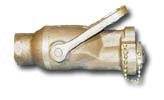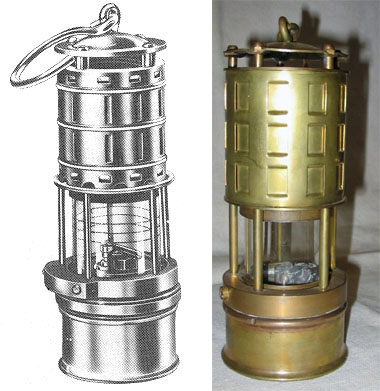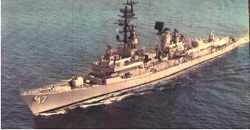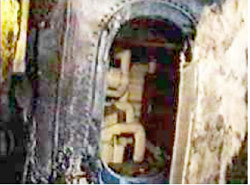 |
 |
 |
 |
| HOME |
| ABOUT US |
| PARTICIPATE |
| COLLECTIONS |
| DC EQUIPMENT MUSEUM |
| SHIP&SUBMARINE MUSEUM |
| WW II DAMAMGE REPORTS |
| SHIPBOARD CASUALTIES |
| DAMAGE CONTROL MUSEUM | ||
|
USS CONYNGHAM (DDG 17), Class Bravo Fire, 8 May 1990 |
||
|
USS CONYNGHAM
Description: Catastrophic failure to the wiper assembly in the fire safe fuel oil strainer. Summary of Events and Causal Factors: USS Conyngham, well drilled in damage control and main space fire techniques, and trained extensively in personnel protection equipment donning, egress and mass conflagration, had achieved excellent scores the previous year at refresher training in Guantanamo Bay, Cuba. The ship was conducting readiness operations off the Carolina coast in preparation for the ship's upcoming deployment. Conyngham had just gotten underway following an intermediate maintenance availability (IMA), during which several pieces of engineering machinery had been overhauled and reinstalled in the ship. These repairs included the duplex strainer serving fire room 1 and the ancillary equipment connected to that system. All equipment had been installed in accordance with the Navy's Maintenance Manual and NAVSHIPS Technical Manual. Because the strainer had been reworked commercially off the ship, however, it was not internally inspected to ensure it had been reassembled correctly. This lack of attention to detail would later prove critical. Another key decision implemented during IMA was the removal and replacement of the balanced joiner (Ellison) door. It had been replaced with a lighter, non-balanced aluminum door from a previous design, shown in Figure 3-3, which proved to be ineffective during the following events. On the morning of May 8, 1990, fire room 2 was providing steam to engine rooms 1 and 2. (Fire room 1 was in cold iron status because of maintenance operations undertaken the night before.) The ship was preparing to light off boiler 1A in fire room 1. Six personnel were in the space, including the EOOW, who was serving as a safety observer. Fuel oil service pump 1A was pressurized and ready to provide fuel to the boiler. The burnerman had just placed his torch in the light-off port when a popping sound was heard. Immediately, the stem on the wiper mechanism to basket A of the fuel oil strainer ejected into the overhead and fell to the deck. A jet of fuel shot into the overhead. The burnerman, reacting instantly, secured the boiler by closing the fuel oil quick-closing valve, stopping the flow of fuel to the boiler. However, the fuel service system remained pressurized with the fuel service pump still online. The fire ignited on the overhead and was immediately reported to DC central.
The immediate actions of the engineers manning the space - to use both PKP extinguishers and AFFF - were timely and correct. However, in less than two minutes, it was clear that fire would consume the space and the order was given by the EOOW to evacuate the fire room. All personnel evaluated their options (all but one donned EEBDs) and departed through the lower level escape trunk as they had been trained to do. Local and remote fuel service shut-downs were not operated because they were both in the path of the fire and thus could not be reached. Smoke and intense heat prevented closing the main access hatch to mechanically isolate fire room 1. Eventually, a crewmember in firefighting coveralls secured the fuel stop on the main deck and started to isolate fire room 1. In just ten minutes, the fire moved unimpeded up the main access, through the aluminum door on the DC deck and into the passageway. It also moved vertically through machinery space ventilation exhausts into the uptakes. The fire melted the ventilation enclosures on the main deck and rapidly moved up toward the bridge. The CO, realizing that the situation was critical, called away general quarters and evacuated DC central, repair stations 2, 3 and 5, combat information center (CIC) and the bridge. Simultaneously, Conyngham transmitted a partial message reporting a major machinery-space fire before all communications were lost. All this transpired in only 15 minutes. The fire then swept down the main deck, moving into the overhead using the cableways for fuel. Because of the suddenness of the fire, all main engineering spaces were open and smoke filled all remaining machinery spaces, forcing all to be abandoned. Evacuation was completed in an orderly fashion using egress plans, OBAs and EEBDs, with few injuries and no loss of life. Conyngham then lost electrical power and went dead in the water (DIW) for approximately 60 minutes. However, electrical power was regained as the emergency diesel generator started. The one fatality in the conflagration occurred when an officer who had evacuated his stateroom returned to alert his roommate of the fire and get him topside. The roommate survived but the officer was later found in their stateroom. He had not used an EEBD, though two were available within easy access of his last location. Electrical power was restored 40 minutes after the start of the fire and fire pumps were brought online to pressurize the firemain. After rapidly overcoming a ruptured firemain line, fire teams formed, set fire boundaries and hose teams started their attack from both forecastle and fantail. The battle lasted approximately three hours, but with assistance from USS Normandy (CG 60) and USS Briscoe (DD 977) the fire was put out. Four 1.5-inch hoses were used to fight fires in CIC. Cableways (under the raised deck supporting the equipment in the space) ignited, which contributed to the intensity of the fire. Using exothermic torches, sailors cut holes in the CIC overhead to vent the space and get hose streams into the space. In addition, at least four holes were cut in the forward stack to allow water to get to the uptakes and extinguish fires. Finally, after an hour had elapsed, a team of machinery space watchstanders fought their way to fire room 2 and engine room 2. They lit fires, closed steam cross-connect valves and gave the ship mobility, which allowed it to position itself with the wind across the bow. This permitted effective desmoking with installed ventilation and contributed significantly to the final extinguishing of the fire. The courage and tenacity of Conyngham's crew was a reflection of the ship's strong leadership and intense training program. The crew's ability to overcome the conflagration after it had taken over the ship demonstrates both professionalism and persistence. It is noteworthy that Conyngham had a shipwide survivability plan which emphasized personnel protection. The crew's ability to defeat the conflagration with minimal loss of life validated that plan. Survivability Principles Applied: Conyngham's crew trained so they would be prepared for the events of May 9. The chain of command had examined the age of the ship and determined a conflagration could definitely be a threat to them. Conyngham's CO had concluded that, due to the age and material condition of the ship, a fire would be an even greater threat than normally would be expected. Conyngham's main space fire doctrine provided the flexibility that enabled the crew to improvise solutions and work around unexpected problems. Their doctrine also emphasized that certain fundamental assumptions made when developing such doctrines can sometimes be eliminated by events. Such assumptions included:
Because of Conyngham's aggressive training program, the crew's professional knowledge was sufficient to enable them to create alternative solutions to overcome the doctrinal assumptions that failed to occur. The cause of the Conyngham incident was attributable to improper repair and installation of the fuel oil strainer. The strainer had not been inspected by ship's company upon delivery to the ship because it was a closed system subject to shore intermediate maintenance activity (SIMA) quality control procedures. Although the new aluminum joiner door installed at the access of the forward fire room was the same size as the balanced Ellison door, it had neither the proper weight nor hinging required to stop the spread of the fire. As a result of this incident, several survivability principles were implemented:
The final evaluation of the Conyngham event shows that good preparation and diligent practice can make the difference in the battle for survival - even against adversity. |
||

